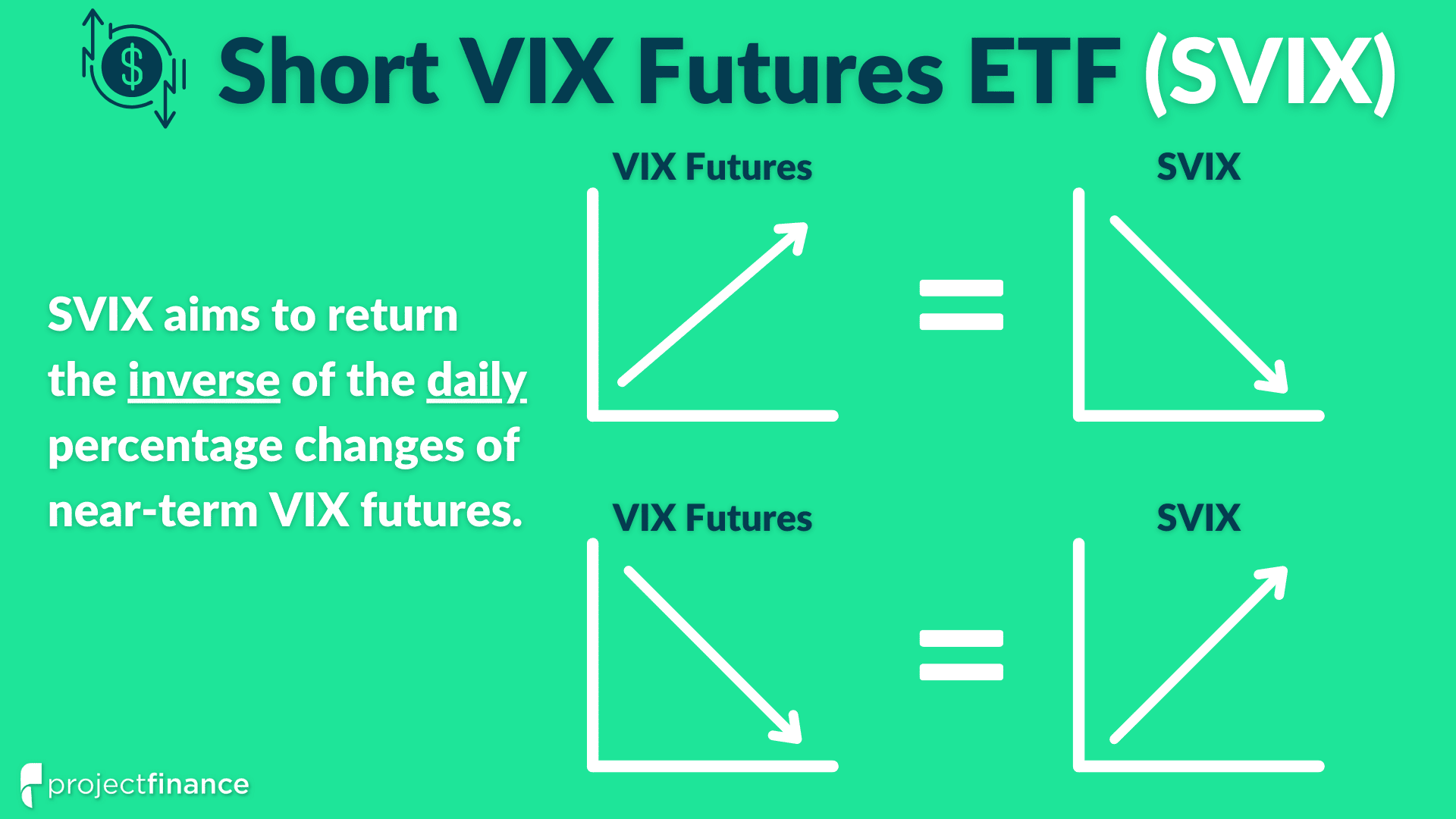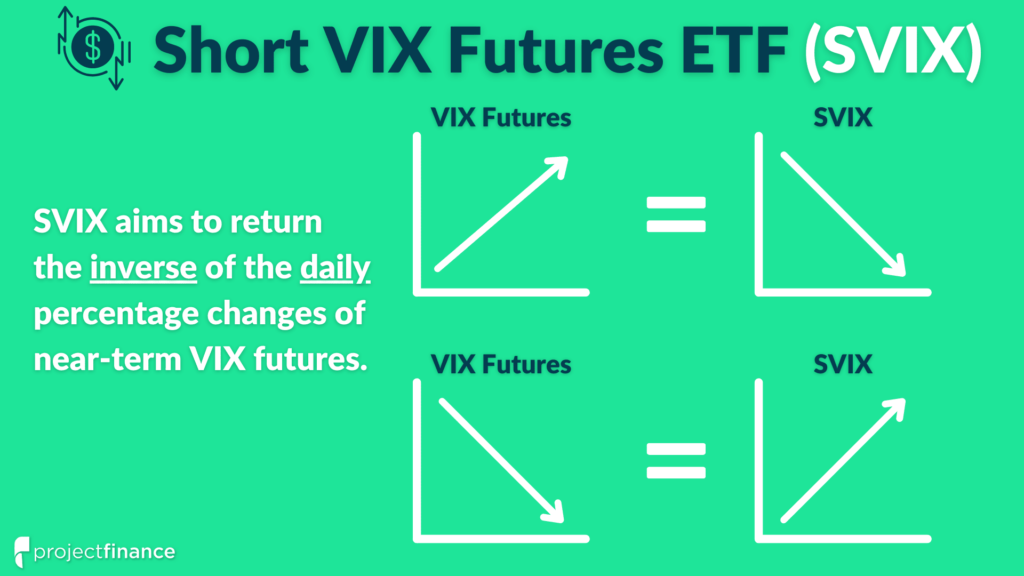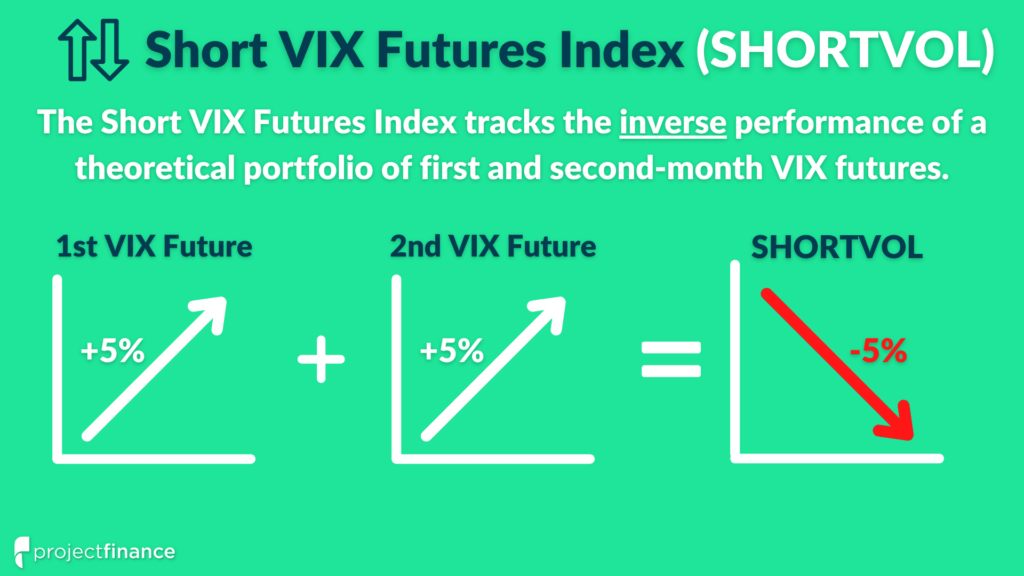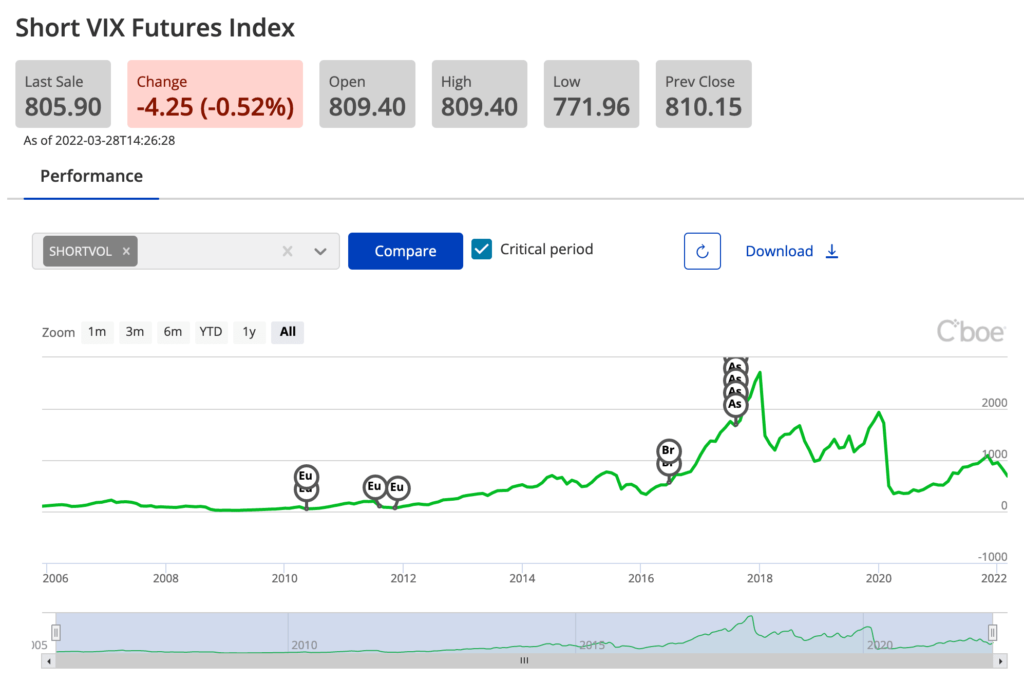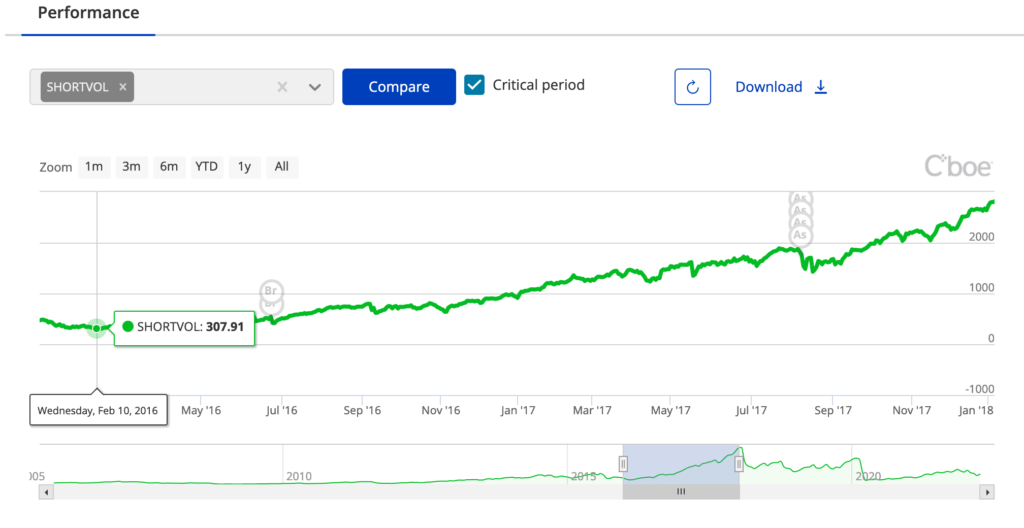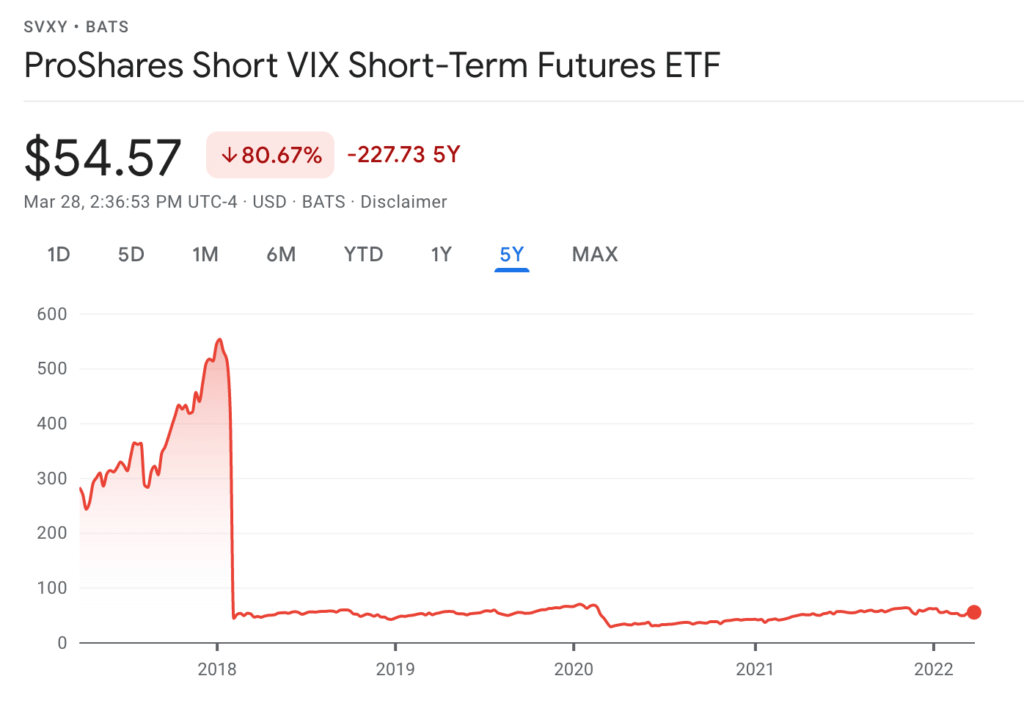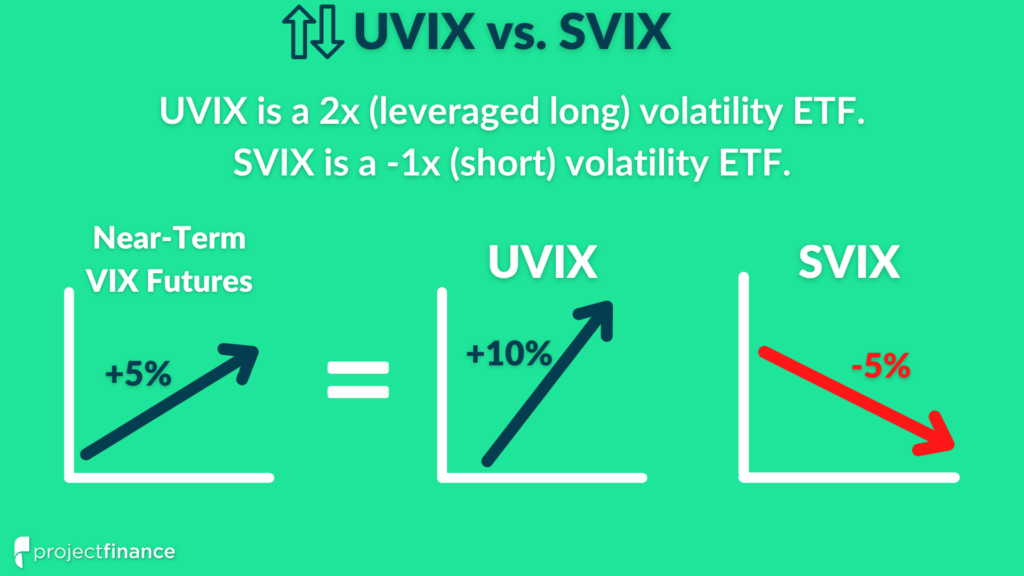Last updated on March 29th, 2022 , 09:54 am
Volatility has become a tradable asset class due to the success of volatility ETPs such as VXX, SVXY, and UVXY.
SVIX is one of the newest products entering the volatility trading space.
What is SVIX and How Does it Work?
The inception date of SVIX is scheduled to be March 30th, 2022. Volatility Shares is the issuer of SVIX.
Let’s explore the Short VIX Futures Index mentioned in the product description to learn how SVIX works.
What is the Short VIX Futures Index (SHORTVOL)?
The benchmark SVIX tracks is the Short VIX Futures Index (SHORTVOL) by Cboe.
Index Methodology: SHORTVOL tracks the daily inverse performance of a theoretical portfolio of first and second-month VIX futures contracts that are rolled daily. The portfolio aims to hold a mixture of the two futures to achieve a weighted average of 30 days to settlement.
If it is February 1st, the first-month VIX future will be the February contract, and the second-month VIX future will be the March contract.
VIX futures track the Cboe Volatility Index (the VIX Index), which increases during times of heightened market volatility and falls during calm market periods.
A short VIX futures position profits when the:
VIX index falls to lower levels, pulling VIX futures contracts lower with it.
VIX futures curve is in contango, causing short-term futures to trade lower as they converge towards the lower VIX index (contango bleed).
The SHORTVOL index will therefore increase during falling or persistently low volatility market conditions.
Bullish SVIX traders are effectively short Cboe volatility index futures.
Bearish SVIX traders are effectively long Cboe volatility index futures.
SHORTVOL Movement Examples
The past performance of the SHORTVOL index informs us about how SVIX should perform under various market conditions:
During extended periods of low volatility, SVIX can increase exponentially as it captures continuous positive daily percentage returns from the decaying VIX futures.
Consequently, the share price of SVIX can compound, as SHORTVOL did during the persistently low volatility of 2016 and 2017:
From January 2016 to January 2018, SHORTVOL went from the low 300s to 2,800, an increase of 833%. SVIX would have experienced a similar return.
But during periods of surging market volatility, SVIX will likely lose substantial value. The faster the increase in volatility, the larger the drawdown SVIX will experience.
In early 2018, the popular short volatility ETF, SVXY, lost over 90% of its value after market volatility spiked:
Source: Google Finance
The short volatility product XIV was terminated following the collapse. SVXY’s leverage was reduced from -1x to -0.5x.
SVIX is the new -1x volatility product, restoring the previously accessible -1x leverage to the short volatility product space.
While SVIX may experience exponential returns during prolonged periods of low volatility, all of its value can be lost in the event of a massive short-term spike in volatility.
What is the Difference Between VIX and SVIX?
The VIX cannot be traded directly. SVIX allows inverse exposure to changes in the VIX index through the VIX futures market.
The Cboe VIX Index is a calculation of market implied volatility using S&P 500 Index options with around 30 days to expiration.
The VIX index cannot be traded as there are no underlying shares. It is only a calculation.
To trade anticipated changes in the VIX index, traders turn to VIX futures and options.
Trading VIX futures is a risky endeavor, as one VIX futures contract represents $1,000 per point in notional value (a large position). A 10-point move in a VIX futures position translates to a P/L of $10,000 on one contract.
SVIX is an ETF that tracks the SHORTVOL index, which tracks -1x the single-day percentage changes of the first and second-month VIX futures contracts.
For instance, if it is February 1st, SHORTVOL will track -1x the single-day percentage changes of a mixed portfolio of February and March VIX futures contracts.
SVIX is a volatility product that allows traders to gain exposure to changes in the VIX index through the futures market.
VIX Index <= VIX Futures <= SVIX
What is the Difference Between UVIX and SVIX?
UVIX, the 2x Long VIX Futures ETF, seeks to provide daily investment returns, before fees and expenses, that correspond to twice the performance of the Long VIX Futures Index (LONGVOL).
UVIX is a 2x leveraged long volatility product.
UVIX aims to return 2x the daily percentage change of a portfolio consisting of first and second-month VIX futures contracts.
SVIX, the Short VIX Futures ETF, seeks to provide daily investment returns, before fees and expenses, that correspond to the performance of the Short VIX Futures Index (SHORTVOL).
SVIX is a short volatility product.
SVIX aims to return -1x the daily percentage change of a portfolio consisting of first and second-month VIX futures contracts.
How Risky is SVIX?
SVIX is a high-risk volatility product.
SVIX should not be held as a long-term “investment.” Buying shares of SVIX does not represent ownership of any business, unlike buying shares of SPY.
During calm market periods where the VIX futures are in contango, SVIX will gain value steadily.
The investment strategy of holding SVIX shares during low market volatility can produce incredible returns, but not without the risk of catastrophe.
In the event of a short-term volatility spike, SVIX can lose all or most of its value, as XIV and SVXY did during the “volmageddon” in 2018.
SVIX is designed for short-term stock and options trading, not long-term investing.
Additionally, the complex nature of SVIX can cause uninformed traders to lose money due to a lack of understanding of the product’s mechanics.
I do not recommend making any trades in SVIX unless confident in your understanding of how it works, and the risks of your specific trades.
How is SVIX Calculated?
SVIX is benchmarked to the Short VIX Futures Index (SHORTVOL).
SHORTVOL tracks the daily inverse performance of a theoretical portfolio of first and second-month VIX futures contracts that are rolled daily.
Each day, the net asset value (NAV) of SVIX should correspond to:
Previous Closing Price + Current Trading Day’s SHORTVOL Change (%)
Example: SVIX closes at $50 on Monday.
On Tuesday, if the SHORTVOL index increases by 3%, SVIX shares should trade at $51.50 ($50 x 1.03).
Conversely, if the SHORTVOL index falls by 10%, SVIX shares should fall to $45 ($50 x 0.90).
The above examples represent no tracking error (perfect tracking of index performance). In reality, exchange-traded products can experience tracking error.
Source: SVIX Prospectus (p.36)
Is There Options Trading on SVIX?
SVIX is a brand new product (inception date of March 30th, 2022) and does not yet have a liquid options market. Time will tell if the options market in SVIX improves.
Does SVIX Pay a Dividend?
No, SVIX does not pay a dividend.
Additional Resources

